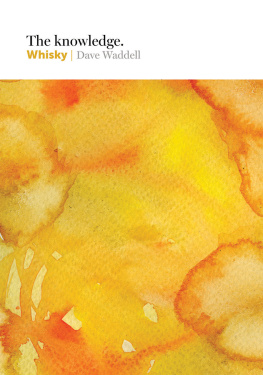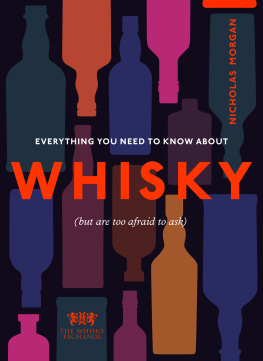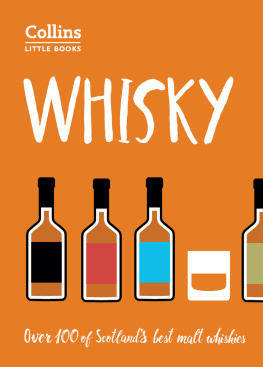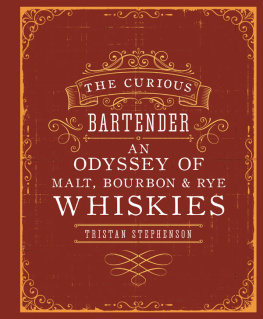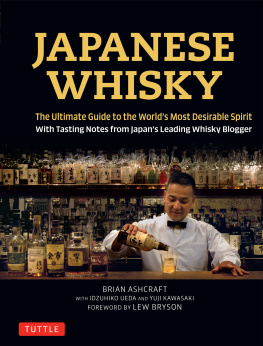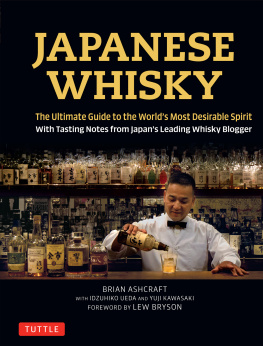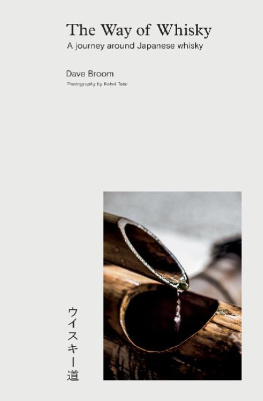For Tash and Otto, with love.
Publishing consultant Jane OShea
Editor Simon Davis
Creative director Helen Lewis
Art direction & design Claire Peters
Illustrator Claire Peters
Production Vincent Smith, Tom Moore
First published in 2015 by Quadrille Publishing Limited
www.quadrille.co.uk
Quadrille is an imprint of Hardie Grant.
www.hardiegrant.com.au
Text 2015 Dave Waddell
Design and layout 2015
Quadrille Publishing Limited
The rights of the author have been asserted.
All rights reserved. No part of this book may be reproduced, stored in a retrieval system or transmitted in any form or by any means, electronic, electrostatic, magnetic tape, mechanical, photocopying, recording or otherwise, without the prior permission in writing of the publisher.
Cataloguing in Publication Data: a catalogue record for this book is available from the British Library.
eISBN 978 184949 693 3
The first time I ever drank whisky I was almost too young to know better. Things ended badly. My grandma had to rescue me. I wouldnt touch a drop of the stuff until a few years ago, on a press trip to Iceland. Bizarrely enough, we were there to taste a rare 45-year-old single malt whisky, the Dalmore Aurora, named after the aurora borealis the northern lights.
Save its name, there is no good reason why we should have been drinking it in Iceland. But we were, and if I was at the time a tad bewildered by the fuss, nobody else was. The whisky itself had been flown in separately, a week prior to our arrival, where it had sat in pride of place at the Hotel Rang, rumours of its presence attracting a steady stream of pilgrims. The idea had been that we would taste beneath the lights, but it was April, the tail end of the season, and it was cloudy. We drank indoors. No matter. The Dalmore Aurora didnt need a light show. It was quite a revelation in its own right.
Apart from being amazed that it tasted nothing like I remembered whisky tasting, I was perplexed by the fact that it was spicy, and tasted of caramel. I couldnt care less that it was just one of 200 bottles in the world or that each went for 3000 a pop. I wanted to know why something consisting largely of ethanol and water should end up brown, light, sharp and slightly sweet, and why some of the group smelt pear and apple, melon, burnt marmalade, while others found roses, jasmine and chocolate. I liked that it had been distilled in stills nicknamed the fat bastards, but I had no idea how the bastards worked, nor the import of words like ex-bourbon, American white or Matusalem.
I wanted to know what all these words meant. I wanted to know why a liquid should smell and taste of things that it was patently not made of. I was yet to learn about the making of flavour, the effect of copper, the influence of wood, but I sensed a science behind the magic.
THIS BOOK IS THE RESULT OF THAT SENSING. ITS SHORT short enough to be read in one sitting. Its designed to give you a good working knowledge of whisky, its production, various histories, its styles and types, an idea of what to drink. Its comprehensive, but its not deep. The whiskies mentioned here are all findable and largely, Id like to say, affordable, but that would be your call. This is a light journey, touching on many things. Its a stepping stone, a means of going from knowing something to knowing something more to wanting to know something else.
To which end, if you have a bottle of whisky to hand, pour yourself a drink. If not, then its up to you, but I would be tempted to pop down to your local bar. It doesnt really matter, but Im hoping that, like my experience in Iceland, you know very little about how that liquid in your glass came to be what it is. Smell it. Take a sip. Take another. Now, start reading. And enjoy. I promise not to bore though I must now break that promise with some history, definitions, terms and arbitrary decision making.

A whisky is defined as a spirit made from a cereal mixed with water, mashed and fermented to make a distillers beer, which is then distilled and aged.
THE BIRTH OF WHISKY
Nobody can say for sure who first thought that distilling beer might be a good idea. There is some evidence that points to distillation being as old as ancient Egypt, where it was more than likely used for the purpose of making perfume. Certainly, the art of purification was well known to Persian alchemists, and their works were translated into Latin as early as the twelfth century. Its generally thought, however, that beer distilled to be drunk as a medicine or restorative, so-called aqua vitae or water of life, was the work of well-travelled Irish monks, having learnt the trade during lengthy stays in the Moorish courts of Spain. From Ireland it is supposed that the court physicians or ollamhs such as the MacBeathads, in the service of Aine OCathain would have carried the knowledge east, onto the island kingdoms of the Hebrides, from which it eventually spread to mainland Scotland.
Most of which we cant really prove: while there are early hints as to its use in Ireland, with soldiers reported to have fortified themselves with shots of uisce beatha (aqua vitae), the first primary evidence, as whisky writer Dave Broom notes, of beer being actually distilled in Britain is to be found in Chaucers Canterbury Tales. We wait another century, though, for actual written mention of aqua vitae being made in the world of nonfiction, a line in the King James IV Exchequer Rolls, which reports the activities of one Brother John Cor, who goes down in most historians books as being the worlds first whisky distiller.
Common sense says otherwise as we shall see. At any rate, the whisky being made at this time and for much of the rest of its history was drunk straight off the stills, either in its raw state, or having been flavoured during distillation, or once flavoured post-distillation. In this sense, it was more a type of vodka or gin than the brown spirit we know today. For that, we would have to wait until the nineteenth century, when spirit stored in oak storage casks was found not only to have turned red, but also to taste better, especially that which had ended up in ex-sherry casks or in ones whose innards had been sanitised by firing.
WHISKY OR WHISKEY?
The Americans and the Irish spell whisky with an e; the rest of the world does not. This simple division is slightly complicated by the fact that a minority of American producers choose to spell it without the e, citing either difference or Old World authenticity as good reason, which isnt necessarily true, but no big deal.
However, for writers, journalists and authors, unless actually quoting whisky or whiskey as in its use as a proper name the Teeling Irish Whiskey Company, for example then the word ought to be spelt consistently, either with or without an e.
In other words, rather than follow publications style guides, which generally follow country leads when it comes to spelling whisky, better that the whisky writer follow the standardised spelling system used by the country in which he or she is writing and publishing. Its logical, therefore, and not at all disrespectful, that I should spell whisky without the e, given that I write in British English.

